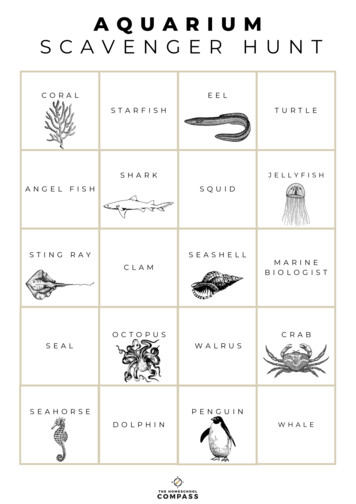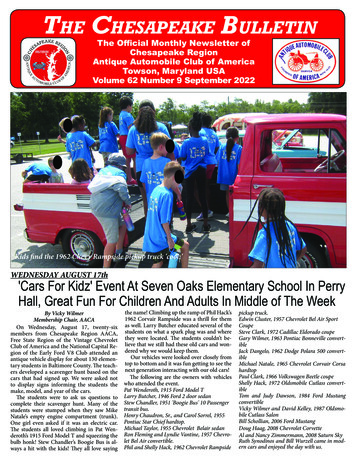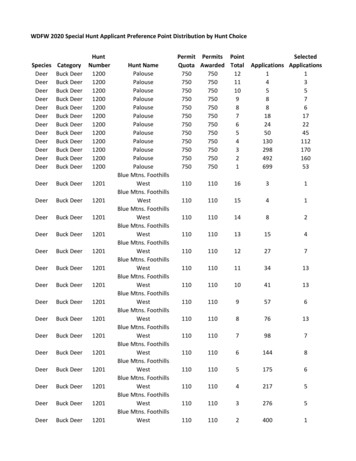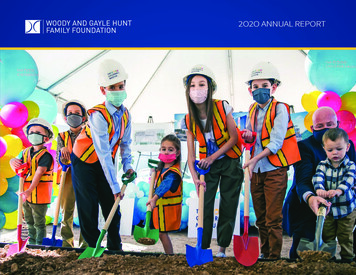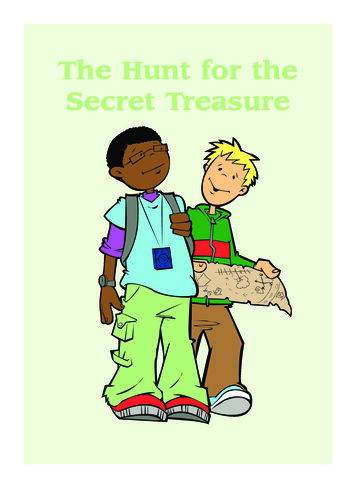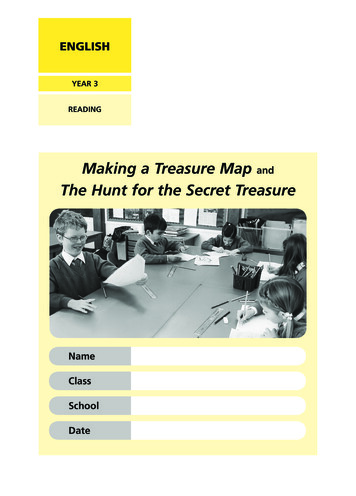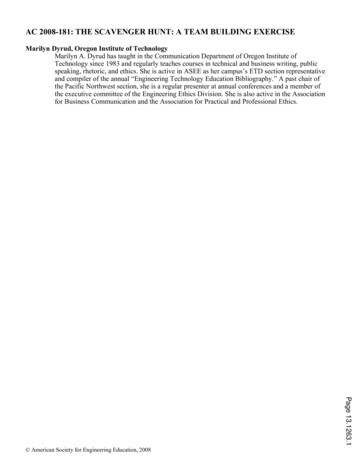
Transcription
AC 2008-181: THE SCAVENGER HUNT: A TEAM BUILDING EXERCISEMarilyn Dyrud, Oregon Institute of TechnologyMarilyn A. Dyrud has taught in the Communication Department of Oregon Institute ofTechnology since 1983 and regularly teaches courses in technical and business writing, publicspeaking, rhetoric, and ethics. She is active in ASEE as her campus’s ETD section representativeand compiler of the annual “Engineering Technology Education Bibliography.” A past chair ofthe Pacific Northwest section, she is a regular presenter at annual conferences and a member ofthe executive committee of the Engineering Ethics Division. She is also active in the Associationfor Business Communication and the Association for Practical and Professional Ethics.Page 13.1263.1 American Society for Engineering Education, 2008
The Scavenger Hunt: A Team Building ExerciseIntroductionFor US companies, team building is big business; in fact, in 2005, American companies spentover 20 billion on team-building activities.1 A quick sweep of the Internet reveals some 44million websites devoted to companies that tailor-make exercises to suit particular companies.Whether it be Enron’s death-defying ATV rides across the Mojave Desert or a simple in-housegame, companies are spending enormous amounts of money in attempts to build a certain espritde corps among employees. Some exercises are active; some are passive. Some are physical;others are intellectual. Whatever the venue, the objective is to produce teams that exhibitsynergy.Most universities are not equipped with either materials or budget to allow instructors the luxuryof taking their students surfing in Maui. However, there are a number of inexpensive, funexercises that can promote congenial collaboration in classes that depend on positive, long-termgroup interactions.This paper focuses on a team-building exercise used in a senior project class that requiresstudents to be in the same groups for 30 weeks; it includes background information onbusiness/industry practices, explains the exercise, and offers student reactions.Current Business/Industry PracticesTeams, as defined by group dynamics experts Johnson and Johnson, are a group on individualswho exhibit these five characteristics: are aware of their positive interdependence as they strive to achieve mutual goalsinteract while they do soare aware of who is and is not a member of the teamhave specific roles or functions to performhave a limited lifespan of membership2Page 13.1263.2
Team building consists of “a series of activities that improve the performance of a team bystrengthening the relationships between team members.”3 Like many things in business, teambuilding activities tend to occur in waves. In the 1990s, physical activities dominated, such aspaintball, beach volleyball, inflated sumo suit wrestling, a Friday night dinner: relationshipbuilding opportunities intended to get people together in a social setting.4 The new millenniumhas ushered in more exotic exercises, such as the now-infamous Burger King firewalk formarketing employees (parodied in a recent episode of the TV series The Office), which resultedin 12 people receiving treatment for first and second degree burns,5 or the spanking of aCalifornia Alarm One employee, which led to a 1.7 million lawsuit for public humiliation.6Tamer examples, with a playful aspect, include Microsoft’s Iron Chef approach to timemanagement: in the UK division, employees were transported to a farmhouse in the Cotswald,divided into five teams, and given seven hours to produce a gourmet three-course meal.Developed by Team Quest, a commercial vendor, the experience also included an assessment ofeffectiveness; according to company data, 55% of participants indicated that the exercise was a“very effective team building event,” and one employee noted that “it was a great way to get toknow the other individuals in the group–I feel more confident approaching other people in thegroup to help with my work now.”7Such “getting to know you” exercises are abundant in business and industry. Another major typeis the “morale booster” activity, such as the Boeing Company’s band room. In 2006, membersof the 777 line, with management encouragement, formed a musical group; they boughtequipment, decorated a room, and set up shop to provide respite for their co-workers, especiallyduring lunch breaks. Office administrator Rebecca Arnold notes that “Our team communicationhas improved because of our music bond.”8Other businesses focus on employee contentment by providing free on-site food trolleys,exercise classes (pilates and tai chi), drink carts, even dry cleaning drop-offs and pick-ups,9 all inan attempt to keep employees happy, develop trust between management and lower-echelonemployees, and stem the exorbitant costs of turnover, estimated at about 140 billion, annually.10A third type of activity is the extravagant Enron-style adventure quests, usually reserved forupper management. Companies hire high-priced vendors to develop challenging activitiesdesigned to develop communication, stress management, and leadership skills. The rationale isto remove people from their usual comfort zones and require them to bond in alien situations.For example, HellermannTyton, a manufacturer of network products and wiring accessoriesbased in Milwaukee, hired Odyssey Experiences to transform a Naples, Florida, private reserveinto a South American jungle, complete with appropriate fauna such as giraffes, alligators, andleopards.10 Campfire Adventures offers dog sledding in Finland and South African safaris.11And Action Centered Training offers thematically based adventures. Its “Inflatable Olympics”includes a rather strange competition: a special suit allows wearers to hurl themselves at aVelcro wall and stick to it.12Page 13.1263.3How effective are team-building exercises? The literature gives mixed reviews. Some employeetestimonials indicate that the event itself led to greater understanding of their co-workers, such as
Terry Tuttle’s comment about the HellermannTyton safari experience, “The teambuildingexercise resulted in camaraderie and a sense of respect and trust.”10 Others are more skeptical,using adjectives such as “childish,”11 “time-wasting,” and “cheesy.”9 As Wall Street Journalcolumnist Jared Sandberg wryly remarks, “everyone in a ‘trust fall’. . . lands safely in the armsof their colleagues. It only proves that colleagues prefer not to be sued.”12It is essential to recognize that team building is a process that cannot be achieved by occasionalevents, however exotic and thrilling those enterprises may be. Team building occurs over time,and such activities serve as “baby steps”13 towards a larger, long-term goal of improved teamperformance.Time in academia, however, differs from time in business. Academic calendars, especially thequarter system, allow for much less time to achieve team goals, and activities therefore must bemore compressed and shorter in duration: most team ventures in higher education strive toachieve team cohesiveness and productivity within a few short weeks.What follows is a description of a “getting to know you,” non-assessment oriented team-buildingexercise in a senior project class, where the students are in the same groups for 30 weeks.However, this exercise is quite versatile and not limited to senior project. Creative instructorscan find a myriad ways to adapt it for other purposes; for example, to familiarize freshmen withtheir new campus, to acquaint students in a research-based course with library resources, or as ameans to foster interdepartmental student relationships.One particular challenge in a team-based senior project is that the students have been together inthe same classes for several years; they know each other, are familiar with each other’s workethic, and have already determined who they want to work with. The students, however, do notchoose their own teams; the faculty do, and we aim for a mixture of talent, academicachievement, and disciplinary interests.The Scavenger HuntThe civil engineering senior project at OIT is a team affair: not only are students in teams for theacademic year, the faculty also functions as a team and consists of four civil instructors (one foreach of the field’s sub-disciplines: geotechnical, environmental, structures, transportation) andtwo communications instructors, in the areas of technical communication and group dynamics.This means that, as a faculty, we must practice what we preach to our students in terms of groupcommunications, as conflicts will inevitably arise. Furthermore, it is an integrated approach,with engineering and communication viewed–and evaluated–holistically, rather than as separatecomponents.Page 13.1263.4To reinforce our initial goal of developing congenial and collaborative teams, we decided toinclude an icebreaker team-building exercise early in the fall quarter; it would provide goodexperience in group problem-solving and task delegation, get students out of the classroom, andinvolve minimal investment. The goal for students was to retrieve as many items as possiblefrom a list of 25. Not all of the items were physical objects; some involved examining campus
monuments or reading trophies in display cases to find the information. Figure 1 is the list forthe 2007-8 senior class.1. A java jacket2. A pinecone3. Who was governor of Oregon in 1962?4. A pamphlet on OCD5. When did David Pott graduate from OIT?6. A copy of Graduating Engineer & Computer Careers7. What is the fine for parking in a handicapped spot?8. A change of address form9. In which building would you find an interferometer?10. When did SME win an award for student chapter excellence?11. A condom12. A campus map13. A fast food wrapper14. Where is the Dennis Findorff survey benchmark located?15. Which building houses the giant sliderule?16. What is the object dedicated to Erik Peterson?17. Who was Harry Boivin?18. A red leaf19. A business card from an OIT engineering/technology faculty member (not civil)20. Who won the Lew Jones Award in 1994?21. An information card for the La Verne College of Law22. A bookmark from the Charles Stewart Mott Foundation23. A 2007-8 FAFSA form24. In which building is the cadaver lab?25. A flyer about an OUS foreign studies programExtra credit: Who said “You are the master of the moments of your life”?Figure 1. 2007-8 scavenger hunt listThe list is a mixture of simple items (pinecones are very common on campus, and each coffeeoutlet has java jackets) and more obscure questions (#10 and #20). Some items are campuslandmarks, such as the small survey benchmark shown in Figure 2.Instructions also include basic ground rules, such asnot using computers or cell phones and not makingcopies of the list (each group of students receivesonly one copy of the list, to promote more sharingand foster problem-solving strategies).Groups that violate a ground rule are disqualified.Establishing time parameters is essential: studentshave 5 minutes to develop a strategy and 25 minutesto find the items.Page 13.1263.5Figure 2. Survey benchmark
We also included an element of fun: because the hunt took place the week before Halloween,groups received official “trick or treat” bags, and each bag had some candies for an extra energyboost.Figure 3 shows one group, Mountain Lakes Engineering, huddled in a pre-hunt strategy meeting.The objective is to develop an approach which uses the allotted time most efficiently. Membersof this team are graduating in winter term.In Figure 4, Lakeside Engineeringholds an interim meeting, todetermine what they still need tocollect. In an 8-person team, studentsdiscovered that communication wasessential.After 25 minutes, the students returnto the classroom and the civil facultycheck their items against the list(see Figure 5). The winning teamreceives prizes: small plastic goldmedals and Halloween PEZ dispensers.Figure 3. Mountain Lakes group strategizingStudent ResponsesIn keeping with the advice from theprofessional literature regarding teambuilding, we also conduct a de-briefing,using the following questions: What did you do for your 5minutes before the hunt?What was your strategy forcollecting items? Did you elect aleader?Was this strategy successful?What what else could you havedone?Figure 4. An interim meetingWas there any conflict on your group? About what?What items were you most successful finding?What items/questions were you unable to find? Why?What did you learn about team building?Page 13.1263.6
In the three years that we have been conductingthis exercise, team sizes have varied,depending on the number of students enrolledin senior project. This year, we have 29students, but last year only 16. The size of theteam, we have discovered, affects the initialstrategy session. Last year, teams collecteditems as “pods,” as one student described it,since each team had only 4 members. Thisyear, with teams of 8, students split intosubgroups and divided the items accordingto building location; two teams even tore thelist into pieces to share out the items.However, the larger team size meant holdingan interim meeting or two, so each subgroupcould report in. No teams elected leaders, buteach depended on team members’ knowledgeof the campus. No teams experienced anyconflict, primarily, they noted, due to the shorttime frame of the exercise.Figure 5. Civil engineering professorMichael Cornachione checks theOptimus Group’s collectionMost teams thought that their strategies were successful. In considering alternatives, one teamnoted that synchronizing watches with the classroom clock would have been useful, as theyunintentionally shorted themselves on time. Another team considered asking for help, butdecided against that; they figured they would receive wrong information, since this was acompetition.The items that were easiest to find were the physical ones: pinecones, java jackets, leaves. Themost difficult included “Who won the Lew Jones Award in 1994?” and the location of thecadaver lab, which had been recently moved to our new health sciences building.Given student responses, the exercise was a successful in raising their awareness about issuesinvolved in team-building. They reported the following as most important: CommunicationTask delegationReading the ground rulesWorking togetherConclusionsPage 13.1263.7Team work in academia is becoming increasingly more important as preparation for thecontemporary workplace, where, as Blau notes, “the team in now the norm.”11 Students do notintuitively know how to function in teams; group dynamics are skills to be learned and honedover a lifetime. A team-building exercise such as the scavenger hunt, when used early in the
term, can help nourish cohesiveness among class members and underscore the importance ofworking together. And, of course, the playful aspect helped boost student and faculty morale.One isolated experience, however, is not sufficient. As business consultant Susan Heathfieldexplains, “You will not build team-work by retreating as a group for a couple of days each year.Think of team-building as something you do every single day.”14 We can achieve that in ourcourses by occasionally using formal team-building activities, such as the scavenger hunt, tocreate an overall atmosphere where students feel comfortable working together to achieve mutualgoals.References1. Vincent, Matthew. “Forget Team Spirit–Back the Big ‘I Am.’” Financial Times Online, October 26, 2007.Retrieved from http://www.ft.com.2. Johnson, David W., and Frank P. Johnson. Joining Together: Group Theory and Group Skills. 7th ed. Boston:Allyn and Bacon, 2000.3. Hunter, Kelly. “How to Make Team Building Ideas Really Work.” Ezine Articles (October 29, 2007).Retrieved from g-Ideas-ReallyWork&id 807410.4. Laff, Michael. “Effective Team Building: More than Just Fun at Work.” TD 60, no. 8 (August 2006): 24-5.5. Barry, Dave. “Burger King Puts Workers’ Feet to the Fire.” The East Carolinian (October 31, 2001).Retrieved from ge/paper915/news/2001/10/31/UndefinedSection/ shtml.6. Woodward, Nancy Hatch. “Make the Most of Team Building.” HR Magazine, 51 no. 9 (September 2006): 72-76.7. Microsoft Culinary Teambuilding–A Recipe for Success. 2007. Retrieved from http://www.quest-thegreatoutdoors.co.uk/team building.php?page Microsoft Recipe4Success teambuild 03 06.8. Lefeber, Scott. “Hitting a High Note.” Boeing Frontiers (September 2006): 21.9. Capps, Brooke. “Playtime, Events, Perks Go Long Way in Team Building.” Advertising Age 78, no. 3 (January15, 2007): 30.10. Graham, Andrea. “Teambuilding Reveals Its Serious Side.” Small Meetings Guide 24, no. 5 (May 2005): S6-11.11. Blau, Rosie. “Playing the Game.” People Management 8, no. 11 (May 30, 2002): 38-9.12. Sandberg, Jared. “Can Spending a Day Stuck to a Velcro Wall Help Build a Team?” The Wall Street JournalOnline (December 26, 2006). Retrieved from cleculture/20070101-cubicle.html.13. Miller, Bran Cole. “Quick Activities to Improve Your Team.” The Journal for Quality & Participation 30, no.3 (Fall 2007): 28-32.Page 13.1263.814. “How to Build Better Teams.” New Zealand Herald (March 6, 2008). Retrieved from the Lexis-Nexisdatabase.
The Scavenger Hunt: A Team Building Exercise Introduction For US companies, team building is big business; in fact, in 2005, American companies spe nt over 20 billion on team-building activities. 1 A quick sweep of the Internet reveals some 44 million websites devoted to companies that tailor-make exercises to suit parti cular companies.


